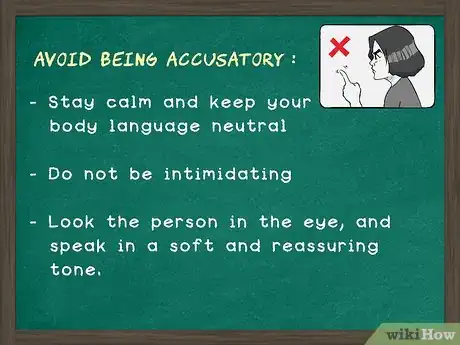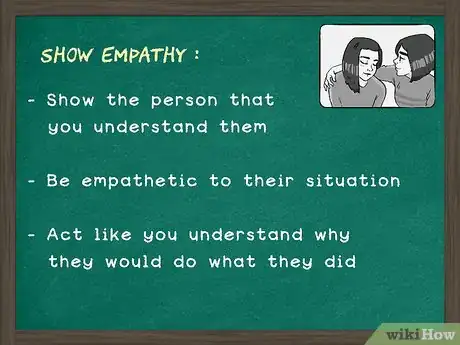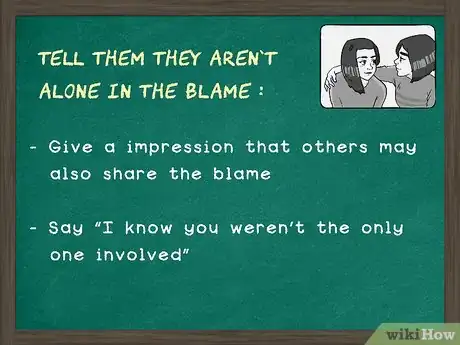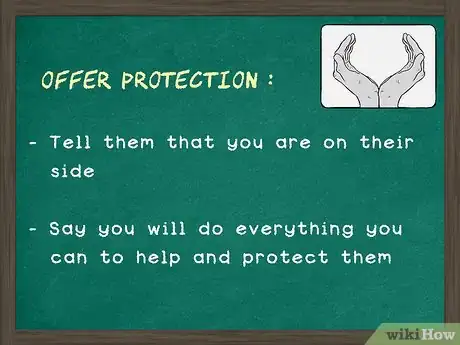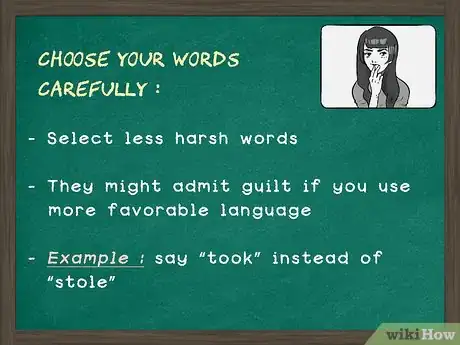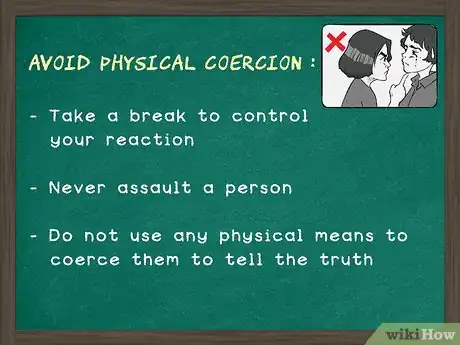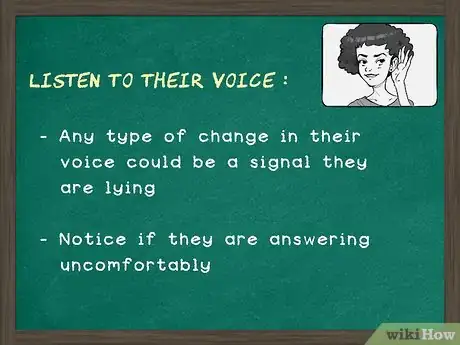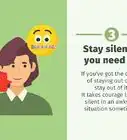This article was co-authored by Klare Heston, LCSW. Klare Heston is a Licensed Independent Clinical Social Worker based in Cleveland, Ohio. With experience in academic counseling and clinical supervision, Klare received her Master of Social Work from the Virginia Commonwealth University in 1983. She also holds a 2-Year Post-Graduate Certificate from the Gestalt Institute of Cleveland, as well as certification in Family Therapy, Supervision, Mediation, and Trauma Recovery and Treatment (EMDR).
There are 8 references cited in this article, which can be found at the bottom of the page.
This article has been viewed 852,310 times.
Knowing how to get someone to tell you the truth is a useful skill to have. It can help you in a variety of situations, including at home and on the job. Although it can take some practice, patience, and confidence on your part, it is achievable and can help you get to the bottom of things. By showing a person you are on their side, starting the conversation in the proper way, and knowing the signs that someone is lying, you increase your chances of finding out the truth.
Things You Should Know
- Show empathy and minimize the severity of the situation so the person is more likely to be honest.
- Tell them you're on their side and that you'll support them if the truth comes out.
- Don't accuse them. The calmer and more reassuring you are, the better.
Steps
Demonstrating You’re on Their Side
-
1Avoid being accusatory. You reduce the chances of getting someone to confide in you if you come off as accusatory. Stay calm and keep your body language neutral. Shouting, banging your fist on a table, and standing with your arms crossed looks intimidating. The person will be more willing to share information with you if they feel like you will understand.
- Sit down, if possible, look the person in the eye, and speak in a soft and reassuring tone. Place your hands on your lap, at your sides, or on the table and keep your facial expression neutral.[1]
-
2Show empathy. Part of establishing trust is showing the person you understand them and are empathetic to their situation. They will be more willing to tell you the truth if they think you won’t blow up at them. Act like you understand why they would do what they did.
- For instance, let's say you catch your son along with a group of peers smoking. You could say “You are denying the fact that you were smoking. But I want you to know I would understand it if you actually were. Sometimes, our peers can pressure us into things we wouldn't normally do.”
- Giving the impression that anyone would do what you suspect they did may make it more likely for them to divulge the truth.[2]
Advertisement -
3Make it seem like the truth isn’t a big deal. People are often scared to tell the truth because they are afraid of the consequences. If you minimize the severity of the situation, however, they may be more likely to confess.
- You could say, “It’s really not that big of a deal. I just want to know the truth.” Assuring them that the wrongdoing isn’t all that serious may make them tell you what really happened.[3]
- However, only go this route if the offense is really not a big deal. For example, it would probably not work with something that has legal consequences or jail time.
-
4Tell them they aren’t alone in the blame. Make the person feel like they aren’t the only one being accused. If they have the impression that others may also share the blame—and consequences—of the situation, they may be more willing to tell the truth. They will likely clam up if they think they are going to suffer the wrath all by themselves.
- You could say, “I know you weren’t the only one involved. There are plenty of other people who are at fault, too.”[4]
-
5Offer protection. Tell the person that you will do what you can to protect them. Convey to them that you are on their side and will do everything you can to help them. They may open up if their fears are eased.
Discussing the Situation
-
1Distinguish between a suspicion and evidence-based accusation. How you approach the situation depends on how much evidence you have supporting any wrongdoing. You will have to handle situations that are based on strong suspicions differently than you would those with clear evidence.
- For suspicions, it's best to present what you suspect in a non-confrontational manner and try to tease out the truth during the interaction.
- For evidence-based accusations, you should state your claim and present the evidence that you have. In these cases, there's little room for the person wiggling out of the responsibility.
-
2Tell a version of their story. Lay out the facts you know by telling the story from your perspective. The person may interject and correct you on part of the story if there’s a detail that is wrong. This may give you a partial confession.
- You can also deliberately change part of the story to entice them to correct you. For instance, you could say, “So you went to the bar last night,” even though you believe they went somewhere else incriminating. This may prompt them to correct you, which could lead you to the truth.[5]
-
3Change things up. Ask the same question over again in different ways. Be mindful of them saying the same phrases when answering, as this could indicate they’ve rehearsed what they’re going to say. They may also be inconsistent with their answers, which could show they are lying.
- You could also ask them to tell their story starting from the end and leading up to the beginning or ask them to start in the middle. Relaying the story back may cause them to create errors in their story, which could show they aren’t telling the truth.[6]
-
4Choose your words carefully. The language you use can play a huge role in whether a person tells you the truth or not. Using language that implies fault may cause the person to withhold. Selecting less harsh words can encourage the person to tell the truth.
- For instance, use the word “took” instead of “stole” or “spent time with someone” rather than “cheated.” The person may be more apt to admit guilt if you use more favorable language.[7]
-
5Bluff, if necessary. Bluffing is a dangerous, yet often effective, tactic. It involves you making a threat or coming out with what you think is the truth, even though you may not really plan to fulfill the threat or have evidence. Your bluff may tempt the person to tell the truth because they feel like they’ve been exposed or are afraid of the supposed consequences.
- For example, you could say, “I have witnesses that saw you at the scene of the crime.” This may be enough to scare the person into the telling you the truth. You could also threaten to go to the authorities or someone in power if the person doesn’t stop lying.[8]
- Keep in mind that verbal threats such as bluffing should only be made if you are certain of the person's involvement or guilt. Also, try to avoid making any sort of threats if at all possible as doing so causes defensiveness, and decreases your chances of getting to the truth.
-
6Avoid physical coercion. If a person stares you in the face and tells you a lie, it may be hard to control your reaction. If you must take a break to collect yourself, do so. But never assault a person or use any physical means to coerce them to tell the truth.
Checking for Clues of Lying
-
1Notice if they answer your question. Evasion is often a hint that someone is lying to you. Trying to change the subject or simply refusing to answer at all is a big clue. Most times a person will talk about anything if they aren’t hiding something.[9]
-
2Listen to their voice. The sound and pitch of a person’s voice will often change if they are lying. Their voice may get higher, they may speak quicker, or you may even be able to hear a quiver in their speech. Any type of change could be a signal they are lying.
- You’ll need to become familiar with the person’s voice to know if they are lying. Start by asking questions you already know the answer to and notice the way they sound as they answer. Move on to questions you don’t know the answer to once you’ve become comfortable with their voice. They are likely lying if there are changes in their voice. However, this would not be the case with a pathological liar or sociopath.
-
3Watch their body language. The appearance of a person can dramatically change if they are lying. Not telling the truth makes people nervous and their bodies often act accordingly. Even the smallest change in their behavior may indicate a lie.
- For instance, a person may try to hide their mouth or their eyes when they are telling a lie. You may also notice them fidgeting, swallowing more, and clearing their throat excessively. They may also avoid looking you in the eye and laugh nervously.[10]
Expert Q&A
Did you know you can get expert answers for this article?
Unlock expert answers by supporting wikiHow
-
QuestionHow can you make someone tell the truth?
 Klare Heston, LCSWKlare Heston is a Licensed Independent Clinical Social Worker based in Cleveland, Ohio. With experience in academic counseling and clinical supervision, Klare received her Master of Social Work from the Virginia Commonwealth University in 1983. She also holds a 2-Year Post-Graduate Certificate from the Gestalt Institute of Cleveland, as well as certification in Family Therapy, Supervision, Mediation, and Trauma Recovery and Treatment (EMDR).
Klare Heston, LCSWKlare Heston is a Licensed Independent Clinical Social Worker based in Cleveland, Ohio. With experience in academic counseling and clinical supervision, Klare received her Master of Social Work from the Virginia Commonwealth University in 1983. She also holds a 2-Year Post-Graduate Certificate from the Gestalt Institute of Cleveland, as well as certification in Family Therapy, Supervision, Mediation, and Trauma Recovery and Treatment (EMDR).
Licensed Social Worker You cannot really make someone tell the truth, but you can encourage it by asking very specific questions. You can also ask follow-up questions if you are not satisfied with the answer you are given (if it is too vague). You can also ask a question that you know the answer to in order to gauge the truthfulness of the person. You can also watch their body language and eye contact while they are responding.
You cannot really make someone tell the truth, but you can encourage it by asking very specific questions. You can also ask follow-up questions if you are not satisfied with the answer you are given (if it is too vague). You can also ask a question that you know the answer to in order to gauge the truthfulness of the person. You can also watch their body language and eye contact while they are responding. -
QuestionHow can you tell when someone is lying by watching their eyes?
 Klare Heston, LCSWKlare Heston is a Licensed Independent Clinical Social Worker based in Cleveland, Ohio. With experience in academic counseling and clinical supervision, Klare received her Master of Social Work from the Virginia Commonwealth University in 1983. She also holds a 2-Year Post-Graduate Certificate from the Gestalt Institute of Cleveland, as well as certification in Family Therapy, Supervision, Mediation, and Trauma Recovery and Treatment (EMDR).
Klare Heston, LCSWKlare Heston is a Licensed Independent Clinical Social Worker based in Cleveland, Ohio. With experience in academic counseling and clinical supervision, Klare received her Master of Social Work from the Virginia Commonwealth University in 1983. She also holds a 2-Year Post-Graduate Certificate from the Gestalt Institute of Cleveland, as well as certification in Family Therapy, Supervision, Mediation, and Trauma Recovery and Treatment (EMDR).
Licensed Social Worker
-
QuestionHow can you tell what the truth is?
 Klare Heston, LCSWKlare Heston is a Licensed Independent Clinical Social Worker based in Cleveland, Ohio. With experience in academic counseling and clinical supervision, Klare received her Master of Social Work from the Virginia Commonwealth University in 1983. She also holds a 2-Year Post-Graduate Certificate from the Gestalt Institute of Cleveland, as well as certification in Family Therapy, Supervision, Mediation, and Trauma Recovery and Treatment (EMDR).
Klare Heston, LCSWKlare Heston is a Licensed Independent Clinical Social Worker based in Cleveland, Ohio. With experience in academic counseling and clinical supervision, Klare received her Master of Social Work from the Virginia Commonwealth University in 1983. She also holds a 2-Year Post-Graduate Certificate from the Gestalt Institute of Cleveland, as well as certification in Family Therapy, Supervision, Mediation, and Trauma Recovery and Treatment (EMDR).
Licensed Social Worker
References
- ↑ https://www.entrepreneur.com/article/282129
- ↑ https://www.truthaboutdeception.com/lying-and-deception/get-others-to-be-honest/practice-empathy.html
- ↑ http://www.scienceofpeople.com/2013/05/how-to-get-someone-to-confess-or-divulge-information/
- ↑ https://www.criminaldefenselawyer.com/resources/criminal-defense/defendants-rights/tactics-police-use-get-a-confession
- ↑ https://www.entrepreneur.com/article/282129
- ↑ http://www.scienceofpeople.com/2013/05/how-to-get-someone-to-confess-or-divulge-information/
- ↑ https://www.jstor.org/stable/40062301
- ↑ https://www.truthaboutdeception.com/lying-and-deception/get-others-to-be-honest/forgive-mistakes.html
- ↑ https://leb.fbi.gov/articles/featured-articles/the-truth-about-lying-what-investigators-need-to-know
About This Article
To make someone tell the truth, try asking them directly what happened. Stay calm and speak in a gentle tone of voice, which will make them more willing to be honest. Use kind language so it doesn't sound like you're accusing them. For example, instead of saying, “Did you steal the money?” say, “Did you take the money?” If the situation isn't serious, make it seem like the truth isn't a big deal. For instance, say something like, "It’s really not that big of a deal. I'm not mad. I just want to know the truth.” For more tips from our co-author, including how to tell if someone’s lying by their body language and tone of voice, read on!
